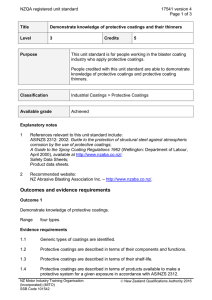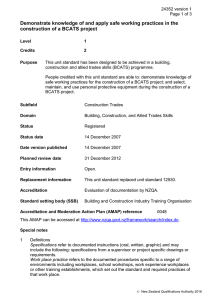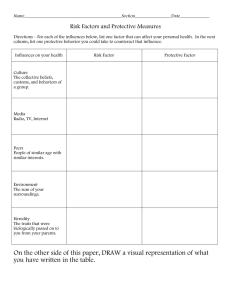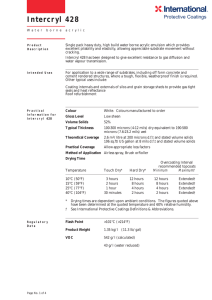Apply protective coatings to electronic products
advertisement
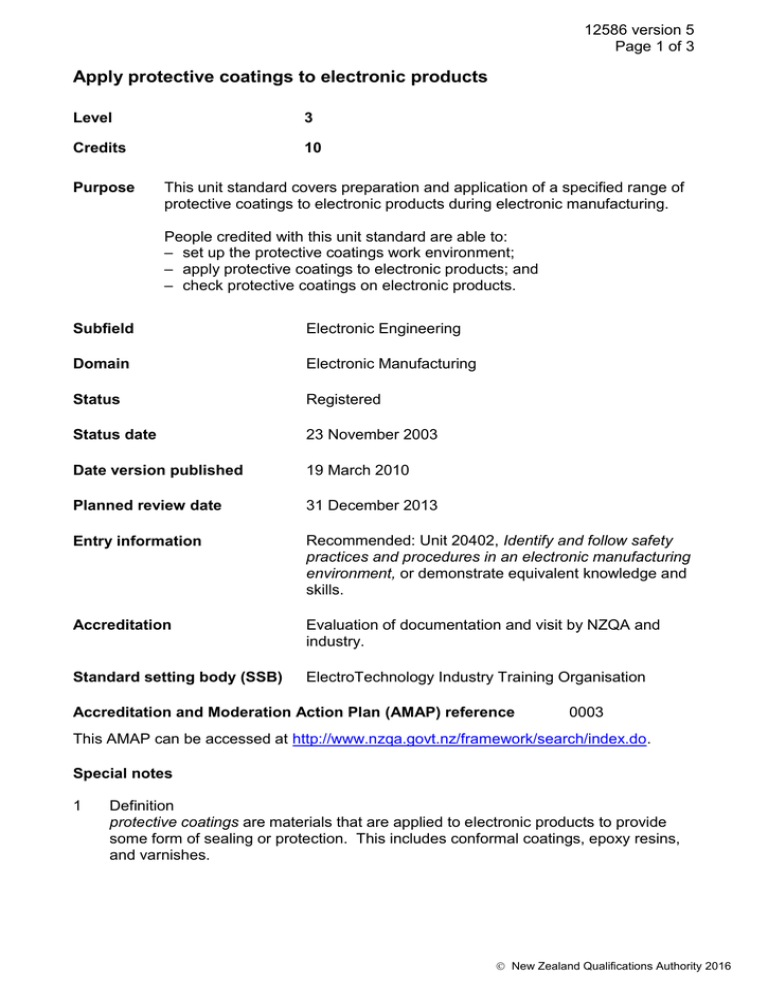
12586 version 5 Page 1 of 3 Apply protective coatings to electronic products Level 3 Credits 10 Purpose This unit standard covers preparation and application of a specified range of protective coatings to electronic products during electronic manufacturing. People credited with this unit standard are able to: – set up the protective coatings work environment; – apply protective coatings to electronic products; and – check protective coatings on electronic products. Subfield Electronic Engineering Domain Electronic Manufacturing Status Registered Status date 23 November 2003 Date version published 19 March 2010 Planned review date 31 December 2013 Entry information Recommended: Unit 20402, Identify and follow safety practices and procedures in an electronic manufacturing environment, or demonstrate equivalent knowledge and skills. Accreditation Evaluation of documentation and visit by NZQA and industry. Standard setting body (SSB) ElectroTechnology Industry Training Organisation Accreditation and Moderation Action Plan (AMAP) reference 0003 This AMAP can be accessed at http://www.nzqa.govt.nz/framework/search/index.do. Special notes 1 Definition protective coatings are materials that are applied to electronic products to provide some form of sealing or protection. This includes conformal coatings, epoxy resins, and varnishes. New Zealand Qualifications Authority 2016 12586 version 5 Page 2 of 3 2 Range a types of protective coatings – one or more of conformal coatings, epoxy resins, varnishes, or other specified materials; b application methods – one or more of – spray, brush, dip, or potting; applied manually or by machine. 3 References Hazardous Substances and New Organisms Act 1996; Health and Safety in Employment Act 1992; IPC-A-610D, Acceptability of Electronic Assemblies, 2005, published by IPC – Association Connecting Electronics Industries. 4 The following apply to all elements of this unit standard: a all activities are to be completed and reported within agreed timeframes; b all work practices must meet worksite's documented quality management requirements; c all activities must comply with policies, procedures and requirements of the enterprises involved, and any relevant legislative and/or regulatory requirements, which include, but are not limited to, the Health and Safety in Employment Act 1992 and the Hazardous Substances and New Organisms Act 1996. 5 People who are registered as physically disabled may achieve this unit standard with exemption from the requirements of element 1 only. Elements and performance criteria Element 1 Set up the protective coatings work environment. Performance criteria 1.1 The selection of all jigs, tools and protective coating materials matches the job instructions. 1.2 The workplace layout conforms to enterprise safety standards and presents no uncontrolled hazards to any person. 1.3 All protective coating materials are handled and stored in accordance with a given procedure. Range examples of procedures could include – enterprise, health and safety, material supplier procedures, or their combination. New Zealand Qualifications Authority 2016 12586 version 5 Page 3 of 3 Element 2 Apply protective coatings to electronic products. Performance criteria 2.1 The protective coating material preparation complies with job instructions. Range 2.2 Electronic product integrity is not affected by setup or coating operation. Range 2.3 preparation includes – composition, handling, storage for use, other specified requirements. integrity includes – structure, electrostatic discharge (ESD), other specified build requirements. All coating operations are completed to enterprise quality standards and may include use of specified jigs, tools and equipment. Element 3 Check protective coatings on electronic products. Performance criteria 3.1 Checking confirms that coating work meets enterprise quality standards. Range IPC standards, coating placement, uniformity, visual appearance. Please note Providers must be accredited by NZQA, or an inter-institutional body with delegated authority for quality assurance, before they can report credits from assessment against unit standards or deliver courses of study leading to that assessment. Industry Training Organisations must be accredited by NZQA before they can register credits from assessment against unit standards. Accredited providers and Industry Training Organisations assessing against unit standards must engage with the moderation system that applies to those standards. Accreditation requirements and an outline of the moderation system that applies to this standard are outlined in the Accreditation and Moderation Action Plan (AMAP). The AMAP also includes useful information about special requirements for organisations wishing to develop education and training programmes, such as minimum qualifications for tutors and assessors, and special resource requirements. Comments on this unit standard Please contact the ElectroTechnology Industry Training Organisation reviewcomments@etito.co.nz if you wish to suggest changes to the content of this unit standard. New Zealand Qualifications Authority 2016

